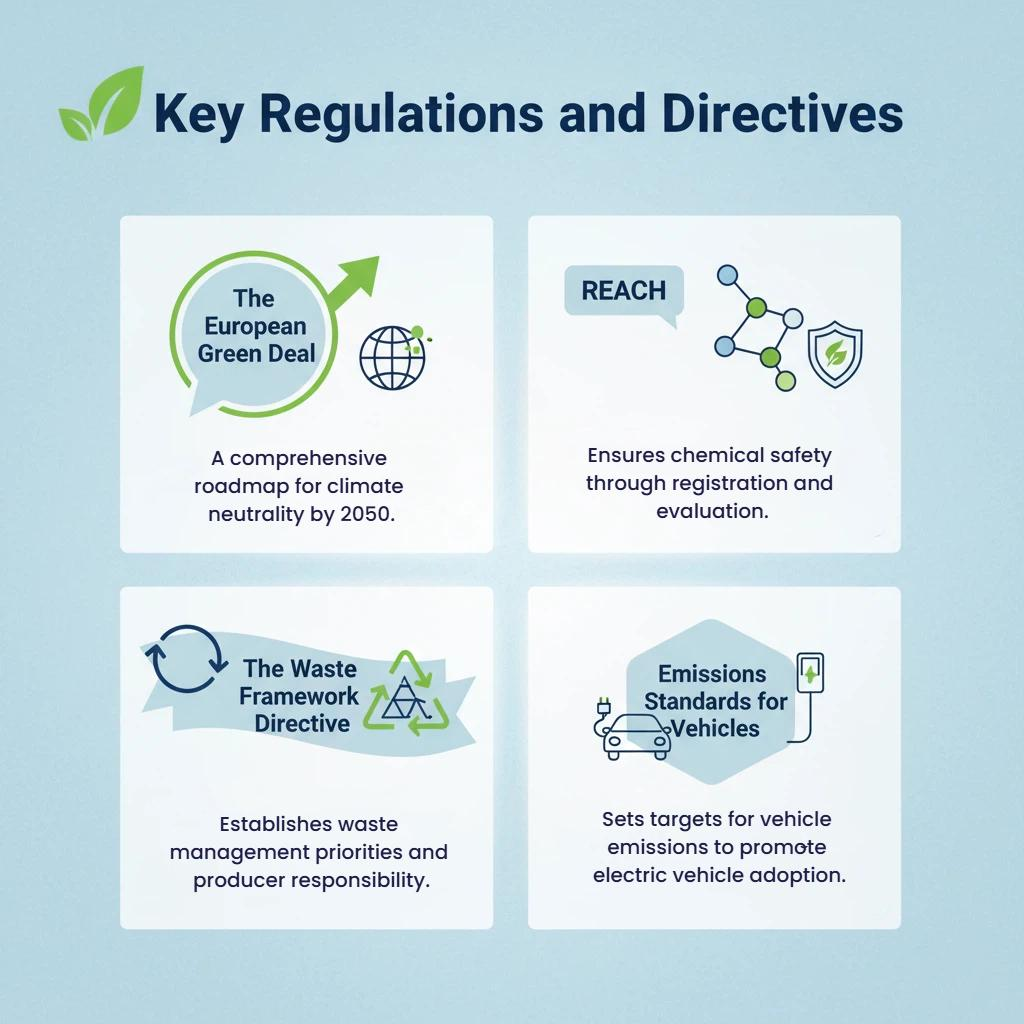As GAC expands into Europe, we are not only introducing new vehicles, but we are also committing to a new vision for mobility. A core part of this commitment is understanding and embracing European environmental law. This robust legal framework is the engine driving the continent toward its ambitious European Green Deal targets. For us, navigating this landscape is not a challenge, but an opportunity to demonstrate our dedication to a shared, sustainable future. We believe that exceptional engineering and environmental responsibility must go hand-in-hand, and we are excited to be part of Europe’s green transition.
The Four Pillars: Core Principles of EU Environmental Law
To understand Europe’s approach, we must first look at the four foundational principles that shape its environmental laws and regulations. These pillars, enshrined in the Treaty on the Functioning of the European Union, guide legislators and businesses like ours.
- The Precautionary Principle:This principle is about being safe rather than sorry. If a policy or action carries a suspected risk of harm to the public or the environment, but the scientific consensus is not yet definitive, protective measures can be taken. It prioritizes caution.
- The Prevention Principle:This is a proactive principle stating that it is better to prevent environmental damage before it occurs than to try and manage it afterward. It shifts the focus from cleanup to clean processes, influencing everything from factory design to product development.
- The Polluter Pays Principle:This principle is straightforward: the party responsible for causing pollution is responsible for paying for the damage it causes. This creates a powerful financial incentive for companies to minimize their environmental footprint.
- The Rectification at Source Principle:This principle asserts that environmental damage should, as a priority, be addressed at its origin. Rather than just treating the symptoms of pollution, this rule aims to fix the root cause, making it a more efficient and effective long-term solution.

Key Regulations and Directives
So, what is environmental law in practice? It is a complex web of two main types of legislation. A “Regulation” is a binding legislative act that applies directly and in its entirety across all EU member states. A “Directive” sets a goal that all member states must achieve, but it is up to each country to devise its own laws to reach that goal.
Here are some of the most critical pieces of legislation:
- The Overarching Framework (The European Green Deal):This is less a single law and more of a comprehensive roadmap. Its primary goal is to make Europe the first climate-neutral continent by 2050.[1] It includes the “Fit for 55” package, which aims to cut greenhouse gas emissions by at least 55% by 2030.
- REACH:This is a key part of European environmental law. REACH (Registration, Evaluation, Authorisation and Restriction of Chemicals) is a regulation that governs the production and use of chemical substances.[2] It places the burden of proof on companies, like us, to demonstrate that the chemicals we use are safe for human health and the environment.
- The Waste Framework Directive:This directive establishes the legal foundation for waste management in the EU. It introduces the “waste hierarchy,” which prioritizes waste prevention, followed by re-use, recycling, recovery, and, as a last resort, disposal.[3] It also reinforces the Polluter Pays Principle by introducing “Extended Producer Responsibility,” making manufacturers responsible for the entire lifecycle of their products, including their disposal.
- Emissions Standards for Vehicles:For the automotive industry, regulations on CO2 emissions are paramount. The EU has set increasingly stringent targets for new cars and vans, effectively creating a mandatory phase-out of new combustion engine vehicles and accelerating the mass-market adoption of electric vehicles.

The Automotive Industry’s Shift to Electric
The automotive sector is at the epicenter of this regulatory shift. Transport accounts for a significant portion of Europe’s greenhouse gas emissions, and the regulations are designed to tackle this head-on. For manufacturers, the challenge is clear: innovate or be left behind.
We at GAC see this as a powerful catalyst for positive change. The solution is no longer debatable; it is electrification. BEVs are the key to meeting and exceeding these stringent standards.
This is why we are proud to introduce our innovative models. Our GAC AION Y, for example, is more than just an electric car; it is our answer to the call for sustainable mobility. It is designed from the ground up to be efficient, clean, and perfectly aligned with Europe’s green ambitions. We are not just complying with environmental law; we are embracing its spirit by providing technology that makes sustainable living accessible and enjoyable.
.jpeg)
Our Commitment to a Greener Europe
The European framework for environmental law is one of the most comprehensive in the world. It is a clear signal that economic growth and environmental protection are no longer competing interests but are, in fact, deeply intertwined.
As GAC Europe, we are fully committed to this vision. Our role is to be a reliable partner in this transition, providing European drivers with high-quality, zero-emission vehicles that do not compromise on performance or style. We believe the future is electric, and with vehicles like the GAC AION Y, we are excited to help drive Europe toward its climate-neutral future.
References
[1]European Commission. (n.d.). A European Green Deal. Available at: https://commission.europa.eu/strategy-and-policy/priorities-2019-2024/european-green-deal_en (Accessed: October 23, 2025)
[2] European Chemicals Agency (ECHA).19 (n.d.). Understanding REACH. Available at: https://echa.europa.eu/regulations/reach/understanding-reach (Accessed: October 23, 2025)
[3] European Commission. (n.d.). Waste Framework Directive. Available at: https://environment.ec.europa.eu/topics/waste-and-recycling/waste-framework-directive_en (Accessed: October 23, 2025)


.png)